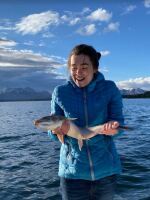As Bristol Bay’s 2018 salmon season continues, seafood processors are grappling with a problem that has loomed large over the industry the past few years – an increasing demand for H-2B visas to fill processor jobs.
On June 30, U.S. Labor Secretary Alexander Acosta and the Alaskan Congressional delegation traveled to King Salmon to meet with seafood processors and transportation companies from Bristol Bay and around the state.
“I’ve always heard you don’t have the population to staff these up,” Acosta said. “Flying in, I have a different view of whether or not you have the population to – it is literally impossible.”
As the meeting got underway, it became clear that one issue was on everyone’s mind: H-2B visas.
Finding people willing to work long, grueling hours in remote locations is challenging. Many companies recruit year-round. They start by reaching out to Alaskans and workers from the lower 48. But while 65 to 70 percent of industry workers in Bristol Bay are domestic, processors can’t hire enough people from the U.S. alone. So, they turn to workers from abroad.

Glenn Reed is president of Pacific Seafoods Processors Association, which represents many Bristol Bay processors. He said that recruiting begins on a state and national level.
“We do start our recruiting with job fairs and working with the state of Alaska seafood employment program to hire Alaskans. We always get a few people out of Alaska, but not a very large number. I would say that fifty out of job fairs and the state employment program would be a large number. We always hire whatever workers we can out of Alaska first, and we’re quickly in the need for quite a few more workers than that – thousands.”
To close the labor gap, processors have increasingly relied on the H-2B visa program. It allows companies to hire temporary workers from other countries. But with increasing demand for visas among seasonal industries like landscaping and tourism, some processors are struggling to obtain any at all.
The program is capped at 66,000 visas annually, split between the first and second part of the fiscal year. But while the number of available visas has stayed the same for years, national demand for the visas has increased dramatically. On March first, the United States Customs and Immigration Services announced that in the first five days, they received approximately 2,700 H-2B cap-subject petitions requesting about 47,000 workers for the second half of the fiscal year – thousands more than the number of visas available. This prompted them to implement a lottery system to distribute visas to companies nationwide this year for the first time. The Department of Homeland Security also added 15,000 additional visas at the end of May, which they had added in 2017 as well.
Some say the increased demand for H-2Bs in the seafood industry is because processors were removed from the J-1 visa program in 2013. Others point to low unemployment in the lower 48, which means fewer people willing to move for a temporary job.
North Pacific Seafoods President and CEO Dave Hambleton said that increased competition for H-2Bs hits salmon processors especially hard. Processors and other industries that operate year-round can apply on January first, while salmon processors can only apply three months before the start of the season. Once granted, visas are valid for a year, giving workers in year-round plants the flexibility to go home between seasons. Combined, these factors create tough conditions for players throughout the industry.
“They may think that they can produce a certain amount if they’re operating at capacity,” said Kris Lynch, Vice President of Pacific Seafood Processors Association. “But if they don’t have the number of workers that they planned on, and they don’t know that until the last minute, if their application is delayed or if there’s a hiccup in the process, it just makes it difficult to plan. And if they do need to adapt to a lower capacity of their workforce then that might mean making decisions about what products they produce. They might have to shift to lower-value products. Certainly, they’re producing less volume as well, so they’re able to sell fewer products. So, there’s a real ripple effect that takes place through the industry.”
Remedies to the H-2B shortfall range from implementing quarterly deadlines to reinstating a returning worker exemption. As the meeting drew to a close, processors also pointed out the uncertainty of the salmon forecast, which makes it difficult for them to balance the number of workers with the run.
“We really don’t know what’s coming, even in Bristol Bay,” said one processor, speaking to the delegation and Acosta. “We have forecasts, we have test fishing that goes on, we have genetic identification of the fish that’s caught in the test fishery, but we still don’t know what’s going to happen.”
According to Hambleton, of North Pacific Seafoods, what processors need most now is certainty.
Contact the author at isabelle@kdlg.org or 907-842-5281.



